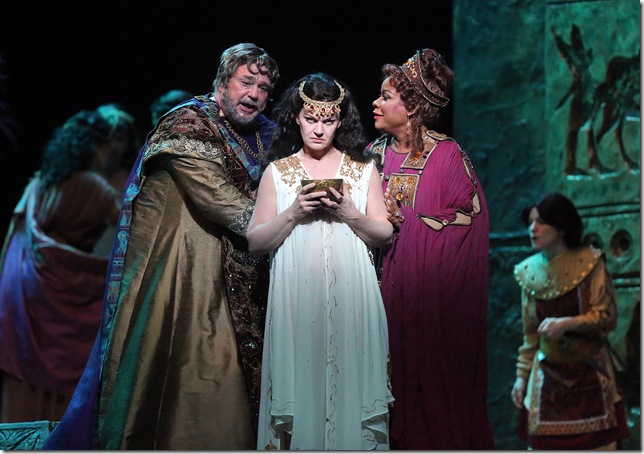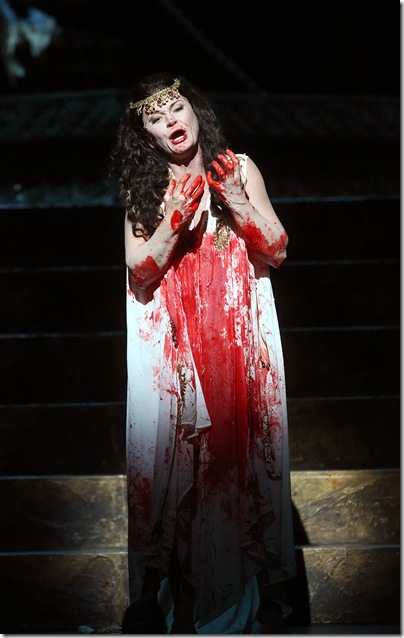Richard Strauss’ Salome has earned its reputation for decadence not just because of its Oscar Wilde source, the time of its composition in the overripe-civilization years of the early 20th century, or its score, with its strange, unexpected sounds at every turn.
It has also earned it because of the story itself, which ends in a parody of Wagnerian bliss, with a cruel but infatuated girl demanding the head of John the Baptist, the man who has spurned her, and after kissing it — with the music finally cadencing in an ecstatic C-sharp major — she is smothered by the soldiers of her revolted stepfather. Many an audience member no doubt has been glad to see Salome come to such a bad end, dying just as her first great, but hopelessly perverse, romantic fulfillment is fresh in her heart.
She dies suddenly, but at the moment of her most profound happiness, and the whole episode is swept away with a hasty curtain, perhaps best understood as an aberrational influence of the diseased moon that looms over the palace of Herodes Antipas, stirring up unhealthy desires and driving people to near-madness.
The Palm Beach Opera production of Salome, which closed Sunday, ending the mainstage 2013 season for the company (Britten’s The Turn of the Screw is performed twice next month by the company’s Young Artists), tried something different: Director Renaud Doucet made his Salome, sung here by the Swedish dramatic soprano Erika Sunnegårdh, a conflicted soul, too young to understand what she has done until it’s too late. He did this by making her act at times like a teenage brat, carelessly lobbing the head of John the Baptist around like a suddenly unwanted toy, showing the immature person still living in the heart of the girl-woman already being urged to a too-potent use of her developing sexual power.
But he also gave her a mannerism: A nervous nail-biting tic, which Salome indulges at her moments of greatest confusion and uncontrollable desires. And here, just after singing her final Straussian line of triumph (I have kissed you, Jochanaan), Sunnegårdh’s face suddenly became a mask of sadness and shock, as she burst into exhausted tears and began ferociously, desperately biting her fingers and nails. It was absolutely shattering, an inspired, brilliant directorial stroke that said in 10 seconds everything you needed to know about this character’s emotional journey right up to the very last moment, when a soldier at Herod’s command gave her the coup de grâce with a knife to the heart.
Doucet could not have made it work so well without a Salome who is not just a good singer, but an excellent actress, and in Sunnegårdh, that is exactly what he had. Her voice is big and sturdy across her entire compass, with a large top that never faltered, and a sweet power when singing some of those beautiful songlines with which Strauss salts his tale. At her quietest moments, such as when she waited over the cistern for the sound of a head hitting the ground, her voice didn’t project clearly, but those moments were rare and ultimately inconsequential.
This was a big, persuasive performance by a singer who knows every note of the opera, who knows how to pace herself for its rigors, and who was able to attempt a new take on this character and make it wholly her own. It was a wonderfully intelligent reading of Salome, and Sunnegårdh sang and acted it beautifully.
As Jochanaan, the American bass-baritone Ryan McKinny was unfortunately not in good voice Sunday, probably from a cold or something similar. It was hard to tell what the quality of his instrument really is, though at times it had a nice color. He was not able to sound his top notes fully, and his lower notes rumbled away with a shaky vibrato that was incongruous for such a young man. Physically, his thin physique was just right for the ascetic prophet, but Kravis Center listeners at this performance will have to hope that McKinny returns in good vocal shape at a future date so they can get a better idea of what kind of singer he is. He deserves great credit for toughing it out and making the best of it.
The American tenor Thomas Moser made a very good Herod, with a strong voice that spoke most powerfully at the very end. He was quite believable as a degenerate prisoner of his own inappropriate lusts, in particular when he almost stamped his feet in frustration as he was confronted with an immovable Salome making an absurd request. In some ways, this is a two-person opera for Herod and Salome, and Moser sang and acted with thorough, impressive commitment.
American mezzo Denyce Graves-Montgomery, who has not that much singing to do as Herodias, nevertheless had the biggest voice on stage Sunday. It’s a huge, commanding sound, and one that was completely convincing for an angry character tired of being insulted by the imprisoned Jochanaan. She was imperious and Lady Macbeth-like, intoning her lines with cold force and granite will; she was a pleasure to watch and hear.
Tenor Nathaniel Peake was a good Narraboth, with a large, pretty sound, and mezzo Megan Marino was a competent Page, with a pleasant, natural sound. The Nazarenes, Jews and soldiers all were well-sung, ably providing an important part of the background.
The orchestra under the Viennese conductor Roberto Paternostro is perhaps the largest ever assembled for a Palm Beach Opera production, and they were wonderful. Paternostro led this very difficult score marvelously well, so that the listener was immersed in the sonic spell of the work from the first slithery clarinet scale to the brutal three-note motifs that end the opera. Particularly notable were the horns, who have an extra-important role to play in the piece, and fulfilled it ideally. This was masterful conducting and expert playing, and it made all the difference in the successful realization of this remarkable opera.
Outside of Salome and Herod, Doucet’s direction was determinedly unfussy, with most of the other singers and supernumeraries essentially standing by in more or less static poses. He kept the action right on the singing characters at all times, and used the stairs on Boyd Ostroff’s relatively plain set for Opera Philadelphia as his staging area for a lot of the negotiations between Herod and Salome.
Costumes, also from Opera Philadelphia, were colorfully Roman Empire, and Guy Simard’s lighting was suitably mysterious and murky, with pinpoint spots for solo introspection. The opera looked good, if a little makeshift at the very bottom of the set, where characters were more or less hanging out.
But this was an impressive production in total, distinguished overall by the strength of its orchestral component and conducting, its excellent lead performance, and its reinterpretation of its title role to make her human, and not simply a symbol of depravity in the early days of the rise of Christianity.
The Palm Beach Opera’s production of Britten’s The Turn of the Screw, a collaboration with Lynn University and starring members of the company’s Young Artists Program, is set for April 12 and April 14 at the Wold Performing Arts Center on the Lynn campus in Boca Raton. Call 835-7550 or visit www.pbopera.org.

